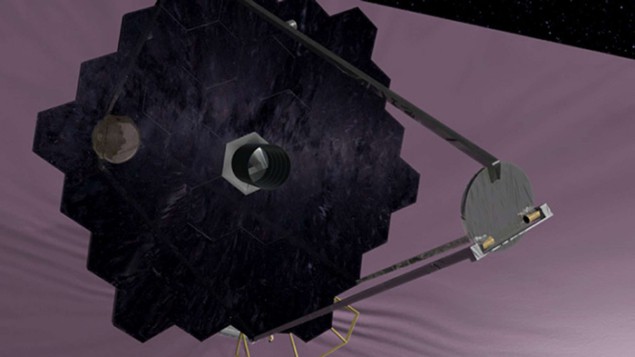
Plans for a new telescope that would be one of the biggest probes ever sent into space have been outlined by a group of astronomers. If the project goes ahead, the probe – tentatively called the High-Definition Space Telescope (HDST) – would feature a 12 m mirror and could be launched in the first half of the 2030s. The plans have been unveiled by a 17-strong committee at the US Association of Universities for Research in Astronomy (AURA), which warns, however, that many additional steps need to be taken to procure funding and develop the necessary technologies before the telescope could be built.
Following the planned launch in October 2018 of the infrared James Webb Space Telescope (JWST), there are no large-scale space observatories on NASA’s schedule. The HDST would detect a similar wavelength range as the Hubble Space Telescope, from near-infrared to far-ultraviolet light, but using a substantially larger mirror than Hubble – 12 m compared with 2.4 m. Because launch systems cannot fit that size of mirror into the rocket fairing, the plan is for the main mirror to comprise 54 segments attached to a foldable backplane.
I’m hopeful that we’ll figure out a way to do it
Marc Postman, Space Telescope Science Institute
Such technology has been developed and is being utilized by the JWST, which has a 6.5 m segmented mirror, yet it is untested on a structure that would be almost twice that size. “I’m hopeful that we’ll figure out a way to do it, in a way that is technically feasible, affordable and can be done on a timescale that is not in the too distant future,” says committee member Marc Postman of the Space Telescope Science Institute in Baltimore, Maryland.
One of the HDST’s main goals would be to study planets around other stars. To do that, the telescope would use a “coronagraph” to suppress light from some 500 to 600 stars individually and hunt for planets orbiting within those stars’ habitable zones – a region where the conditions could support liquid water on an exoplanet’s surface. According to Postman, once the HDST finds these worlds, it would be possible to get a spectrum of the planet that could tell astronomers whether or not there are “potential signs of life as reflected in the atmosphere of the planet”.
Focus on galaxy formation
In addition to its exoplanet observations, the HDST could measure how most of the stars in our galaxy move over the course of 10 years. It could also study the 3D motions of nearby galaxies compared with more distant ones, revealing characteristics about the nature of dark matter. The telescope, moreover, would be the first instrument to resolve how gas flows in and out of galaxies, a crucial observation for understanding galaxy formation.
Heidi Hammel, AURA executive vice president, says that the committee incorporated lessons learned from the JWST, a project that is over budget and has suffered delays. While the report does not touch on the costs required to construct the HDST, astronomers hope the study will now influence those at NASA who oversee technology development so that it is studied further.



